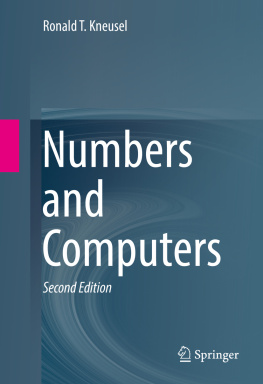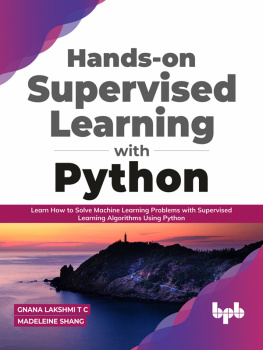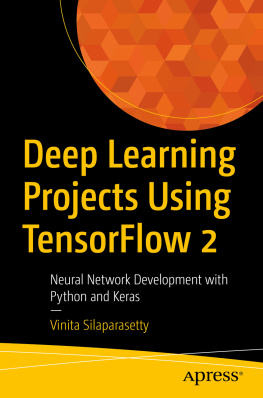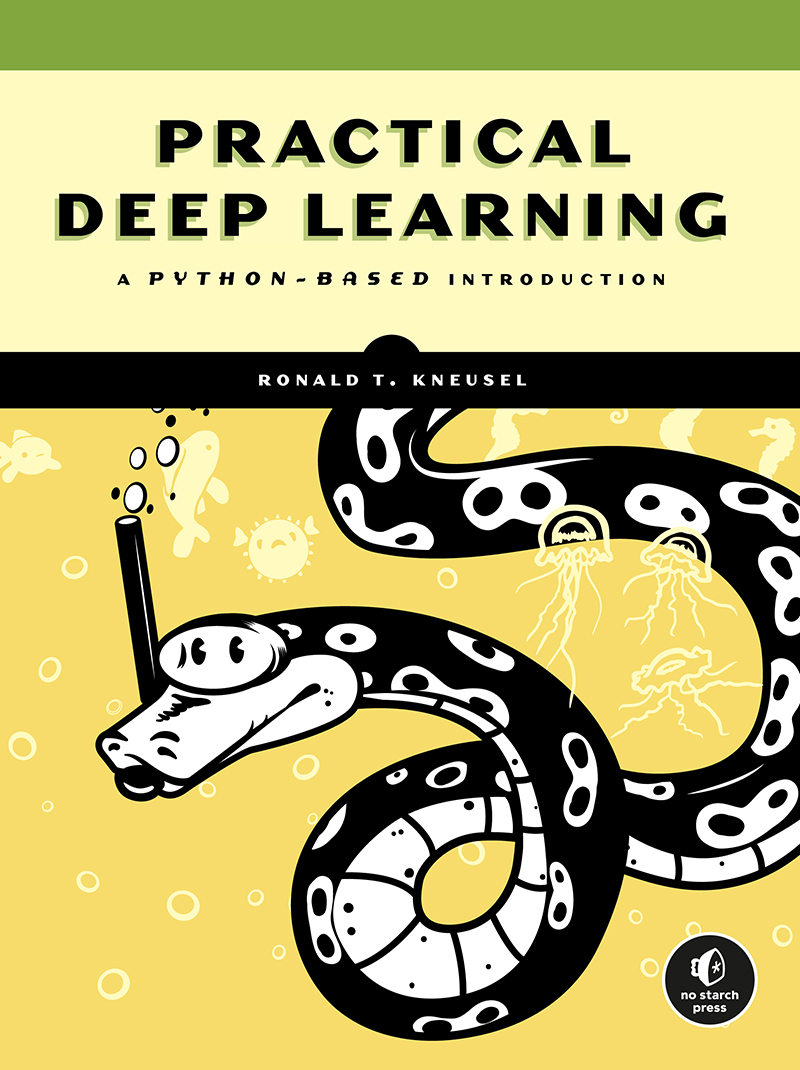Contents in Detail
PRACTICAL DEEP LEARNING
A Python-Based Introduction
by Ronald T. Kneusel
San Francisco
PRACTICAL DEEP LEARNING. Copyright 2021 by Ronald T. Kneusel.
All rights reserved. No part of this work may be reproduced or transmitted in any form or by any means, electronic or mechanical, including photocopying, recording, or by any information storage or retrieval system, without the prior written permission of the copyright owner and the publisher.
ISBN-13: 978-1-7185-0074-7 (print)
ISBN-13: 978-1-7185-0075-4 (ebook)
Publisher: William Pollock
Executive Editor: Barbara Yien
Production Editor: Dapinder Dosanjh
Developmental Editor: Alex Freed
Cover Illustration: Gina Redman
Interior Design: Octopod Studios
Technical Reviewer: Paul Nord
Copyeditor: Chris Cartwright
Proofreader: Sharon Wilkey
The following images are reproduced with permission. )
For information on book distributors or translations, please contact No Starch Press, Inc. directly:
No Starch Press, Inc.
245 8th Street, San Francisco, CA 94103
phone: 415.863.9900; fax: 415.863.9950;
Library of Congress Cataloging-in-Publication Data
Names: Kneusel, Ronald T., author.
Title: Practical deep learning : a python-based introduction / Ronald T. Kneusel.
Description: First edition. | San Francisco, CA : No Starch Press, Inc.,
[2021] | Includes index.
Identifiers: LCCN 2020035097 (print) | LCCN 2020035098 (ebook) | ISBN
9781718500747 (paperback) | ISBN 9781718500754 (ebook)
Subjects: LCSH: Machine learning. | Python (Computer program language)
Classification: LCC Q325.5 .K55 2021 (print) | LCC Q325.5 (ebook) | DDC 006.3/1dc23
LC record available at https://lccn.loc.gov/2020035097
LC ebook record available at https://lccn.loc.gov/2020035098
No Starch Press and the No Starch Press logo are registered trademarks of No Starch Press, Inc. Other product and company names mentioned herein may be the trademarks of their respective owners. Rather than use a trademark symbol with every occurrence of a trademarked name, we are using the names only in an editorial fashion and to the benefit of the trademark owner, with no intention of infringement of the trademark.
The information in this book is distributed on an As Is basis, without warranty. While every precaution has been taken in the preparation of this work, neither the author nor No Starch Press, Inc. shall have any liability to any person or entity with respect to any loss or damage caused or alleged to be caused directly or indirectly by the information contained in it.
For my children: David, Peter, Paul, Monica, Joseph, and Francis.
About the Author
Ron Kneusel has been working with machine learning in industry since 2003 and completed a PhD in machine learning from the University of Colorado, Boulder, in 2016. He currently works for L3Harris Technologies, Inc. Ron has two other books, both available from Springer: Numbers and Computers, and Random Numbers and Computers.
About the Technical Reviewer
Paul Nord works for the Valparaiso University Department of Physics and Astronomy as a technical specialist and research assistant. He is a 1991 graduate from Valparaiso University with a degree in physics. He also earned a masters degree in analytics and modeling from VU in 2017. Paul has worked on numerous machine learning projects, including the Disk Detective Collaboration, a Faculty Learning Community discussion group, and an art show using Google Deep Dream. Pauls other activities include science outreach programs for kids of all ages.
BRIEF CONTENTS
CONTENTS IN DETAIL
FOREWORD
Since the dawn of the modern digital era, scientists and engineers have taken inspiration from the human brain to imagine how massively parallel networks of simple neuron-like processors might learn and adapt from experience. There have been waves of excitement in this topic as new mathematical methods were developed. In 1958, Frank Rosenblatt proposed a learning device called the Perceptron, which had the amazing property that it could learn any task that one could program it by hand to perform. The enthusiasm for this device vanished when Marvin Minsky and Seymour Papert performed a careful analysis showing limitations on what the device could be programmed to do, both in principle and in practice.
In the late 1980s, cognitive scientist David Rumelhart, along with Geoffrey Hinton and Ronald Williams, proposed a learning algorithm called back propagation that had the potential to overcome the limitations identified by Minsky and Papert. Impressive demonstrations of the algorithm, such as a text-to-speech system called NetTalk, led to another surge of interest in neural networks. This time, enthusiasm in the field was dampened when the algorithm did not seem to scale up to handle larger problems.
Over the next 20 years, computers got faster, datasets got larger, and new software tools made it easier to build neural networks. With these developments, much larger models became feasible. The field was rechristened deep learning, and a new generation of practitioners were able to tackle problems on a scale that was previously unimaginable.
Although history suggests that we will once again hit a wall with modern deep learning, the field has proven that it can solve difficult, practical, high-impact problems. From voice-controlled assistants to human-expert-level diagnosis of medical images to autonomous vehicles to myriad other behind-the-scenes applications, our lives have been transformed. The deep learning revolution is upon us, and the future holds untold promises of capabilities yet to come.
One might think that such advanced technology is beyond the understanding of most of us, but the underlying principles are quite understandable and accessible. Indeed, the academic grandparents of the deep learning revolution were psychologists by training. A standard desktop computer with open source software tools is adequate to explore the ideas and concepts in this textbook. With a modest investment in hardware upgrades (notably, a graphics processing unit, or GPU), the computer becomes what would have been considered a supercomputer a decade ago, enabling sophisticated research and implementation.
Dr. Kneusel is an expert in image processing and has over 15 years of industry experience with machine learning. He wrote Practical Deep Learning to make the field approachable to novices and hobbyists. With no assumption of background knowledge, it starts at the beginning. It shows how to build a dataset that will be useful for training a successful deep learning model. It then explores classical machine learning algorithms with the intent of grounding the methods that led to the deep learning revolution.
Practical Deep Learning provides not only a solid conceptual foundation but also the practical guidance readers will appreciate to design their own projects and solutions. It addresses how to tune and evaluate the performance of a machine learning model via the standards of current practice. Throughout the book, intuition is emphasized. Practical knowledge builds on intuition.
Practical Deep Learning also serves as a springboard to help launch you on to more advanced treatments of the methods and algorithms. The last four chapters dive into convolutional neural networks, a workhorse of supervised deep learning. The experiments in these chapters use standard datasets familiar to all those who work in the field. These chapters culminate in a case study, an example of how to approach a problem, from a dataset to evaluating a predictive model.







